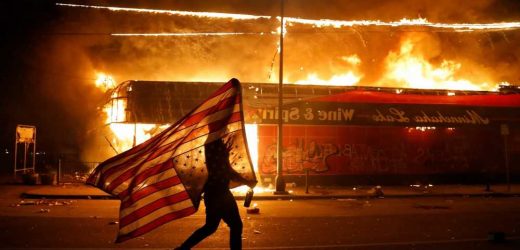More On:
riots
Brooklyn protest suggests BLM is just about hate and rage
Florida Gov. Ron DeSantis signs controversial ‘anti-riot’ bill
Two Proud Boys leaders ordered locked up pending Capitol riot trials
‘Twisted’ justice in Minneapolis and other commentary
When Americans fight about race or culture, the fight is almost always really about social class. And that shows up in today’s discussions about riots and policing.
The Daily Caller recently sent a video correspondent to Brooklyn Center, Minn., scene of many police-shooting-related riots, and to Washington, DC, home of America’s ruling class, and asked people in both places when and if rioting was justified. The answers differed sharply.
In Brooklyn Center, where the destruction was visible firsthand, respondents (nearly all black men of various ages) overwhelmingly opposed rioting. An African-American man in an “Army Veteran” hat commented: “We’re human, and we want to be treated with respect,” but we also need to show “respect.”
A man in construction gear remarked: “I guarantee you the people that were looting, nine times out of 10, weren’t from this area. . . . If you feel the need to lash out, then don’t get mad when people, you know, address you as a looter or a rioter.”
A woman in a Black Lives Matter mask agreed: “These are two different things: We have protesters, and then we have rioters.”
The people of Brooklyn Center seemed to hold a pretty nuanced view about the difference between protest and destruction.
On the streets of Washington, on the other hand, support for riots among the capital’s bourgeoisie was almost universal. One young woman said that “if change needs to be made, and it’s not getting done in the traditional avenues, then rioting is a good option.”
Another opined, “I think that all violence is bad violence, but in the case where systems aren’t responding to any other forms of change, I can understand people getting frustrated to the point where they need to take other avenues.”
A third commented that looting is “very small compared to” the “systemic oppression” in America. Many more echoed such views.
At one level, the gap is surprising: The “oppressed” seem less enthusiastic about riots than those who worry about their oppression. At another level, it’s not surprising: The people whose neighborhoods are being destroyed are less sanguine about the destruction than are those who observe it from the comfortable environs of our nation’s capital.
(The Caller did manage to interview one black man in DC who commented that “peaceful protest has more impact on what’s going on.”)
But this is mostly a class divide. The women interviewed in DC share the up-talk and vocal fry that characterize well-off, college-educated young women today. They aren’t people who run or depend on small businesses that can be ruined by one night of destruction; they aren’t people whose wages might suffer from business closures following mass violence. They speak in the most abstract of tones.
We saw this in the 1960s with the rise of “radical chic,” in which (as the writer Tom Wolfe memorably noted), tony Upper-East-Side types shared cocktails with Black Panthers. Many of the most violent New Left revolutionaries of the 1960s and ’70s were the privileged children of wealthy parents. And even today, there’s a lot of voyeurism among those encouraging violence.
Last year, sports reporter Chris Martin Palmer became the face of this sort of thing when he tweeted a photo of a burning building in Minneapolis with the caption “Burn that s–t down!” (The burning structure giving him voyeuristic tingles was, it turned out, a low-income housing project, the Minnehaha Commons affordable-housing project.)
Palmer’s tune changed when rioters came to his neighborhood. He fumed: “The[y] destroyed a Starbucks and are now in front of my building. Get these animals [the f–k] out of my neighborhood. Go back to where you live.”
The thing is, it’s a lot easier to encourage violence when the consequences happen to someone else. Too much of upper-class America is cocooned from real risk. For the people in poor and working-class neighborhoods where riots and looting tend to happen, the consequences are much more apparent.
That’s why the cavalier attitude of so many Democrats toward riots makes sense. Democrats are now the party of Wall Street, Silicon Valley and upscale suburbs. The people who have to deal with consequences will have to go somewhere else politically. And they will.
Glenn Harlan Reynolds is a professor of law at the University of Tennessee and founder of the InstaPundit.com blog.
Share this article:
Source: Read Full Article


